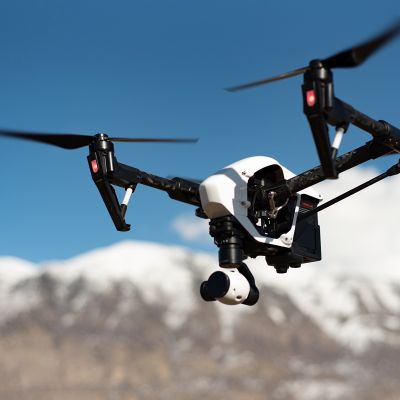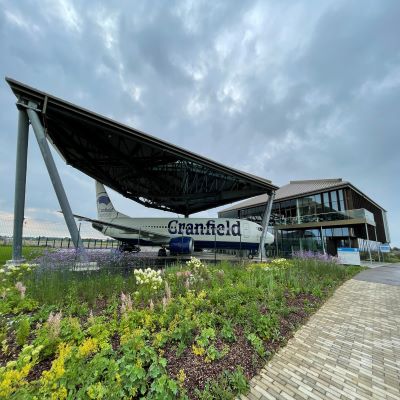- First-of-a-kind ecosystem will demonstrate the commercial and operational viability of Advanced Air Mobility (AAM) and accelerate the introduction of AAM and air taxis
- Cranfield’s role will focus on vertiport capacity modelling and the optimisation of schedule and resource management
- Demonstration of urban and cross-country flights planned at London Heathrow, Bristol, London City airports and a new vertiport at a London General Aviation (GA) airport
Cranfield University is partnering with leading British aviation companies in a new consortium to develop key technology and infrastructure that will significantly accelerate the introduction of Advanced Air Mobility (AAM) in the UK. The project will help pave the way for air taxis taking to the skies, creating fast and sustainable flight options between cities.
The Advanced Mobility Ecosystem Consortium has been awarded a £9.5 million grant by the UK Government’s Future Flight Challenge to develop the essential building blocks of a viable AAM ecosystem that has the potential to be progressed into full commercial operations.
Gary Cutts, Future Flight Challenge Director at UK Research and Innovation said: “Our roadmap sets out how air taxis could be in use in the UK by 2030, but a lot needs to occur for that to happen. By bringing technical developments from across the aviation industry together into one network, and undertaking early demonstration in the real world, the Advanced Mobility Ecosystem Consortium could accelerate the timescale for AAM introduction by years. This project could revolutionise travel, not just in the UK but around the world.”
Cranfield will work with Vertical Aerospace, Virgin Atlantic, Atkins, Skyports and NATS, along with Connected Places Catapult and WMG, University of Warwick to create and test technological developments in aircraft electrification, airspace management, ground infrastructure, operational procedures and the systems and supporting business cases required to implement a new model of aerial passenger transport in the UK.
Benefits of Advanced Air Mobility
AAM offers a new form of travel, enabling cost-effective connectivity into congested urban areas and across regions under-served by existing infrastructure. Electric flights linking with each other will provide more direct emission-free connectivity between a wider number of destinations, with the potential to reduce congestion of terrestrial transport arteries.
The UK Government Future Flight Challenge forecasted that the introduction of AAM services will increase UK GDP by 1.8% by 2030 and support the Government’s Levelling Up and Net Zero agendas, reflecting the productivity and wider economic benefits of increased connectivity.
Other nations are already racing to establish their own AAM ecosystems by 2025 and this project ensures the UK will be amongst the leaders in this new decarbonised form of transport.
Developing the vertiports of the future
Cranfield’s role will focus on the vertiport (a type of airport for aircraft that land and take off vertically) infrastructure for the project and includes capacity modelling and the optimisation of schedule and resource management. The research will investigate airspace operational constraints and examine passenger processing areas, times, convenience and efficiency in the establishment of AAM as a new service to the public.
Professor Antonios Tsourdos, Head of the Autonomous and Cyber-Physical Systems Centre, Cranfield University, said: “This consortium will develop and implement a brand-new transport system for the UK in the form of AAM. Cranfield’s cutting-edge expertise in aircraft electrification, airport planning and air traffic management will underpin the operations of this first-of-a-kind ecosystem, making electric flight a reality.”
The allocation of vertiport services on air and landside, including security aspects along the journey and relevant access points at downtown and suburban landing pads, will be critical to AAM. Cranfield researchers will model passenger throughput based on vertiport size and spatial organisation, aircraft size, processing times, business rules and regulatory requirements.
Henrik Rothe, Senior Lecturer in Airport Planning / Management in the Centre for Air Transport Management at Cranfield University, said: “Passenger expectations and behaviour will shape the infrastructure requirements for landing pads and vertiports. The work I will be guiding will focus on the development of a highly integrated vertiport infrastructure to realise AAM, including support infrastructure such as landside access, aircraft parking and charging spots, and gate areas for embarking and disembarking aircraft.”
Dr Yan Xu, Lecturer in Air Traffic Management and Communication Navigation and Surveillance in the Autonomous and Cyber-Physical Systems Centre at Cranfield added: “The development of an integrated scheduling service is crucial for airspace and vertiport resource management, including arrival and departure applications. It’s vital to consider operational constraints such as aircraft capabilities, and model prioritisation schemes for flights, potentially under a collaborative decision-making mechanism between airspace navigation, vertiport operators, ground handlers and land-based transport.”
Read full details about the project and consortium here.






